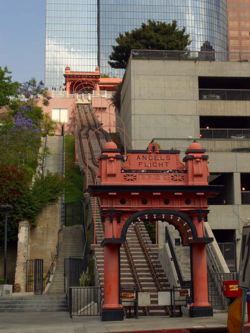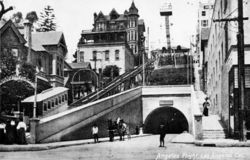Angels Flight
Angels Flight is a landmark funicular railway in the Bunker Hill district of downtown Los Angeles, California, which claims to be the "shortest railway in the world". The funicular has operated on two slightly different sites, using the same cars. The first Angels Flight operated from 1901 until it was closed in 1969 when its location was redeveloped. The second reopened nearby in 1996, and closed again in 2001 after a serious accident. The second funicular still exists but does not operate, and it is scheduled to reopen in Summer 2007.[1]
Contents
The first Angels Flight
Built in 1901 as the Los Angeles Incline Railway, running northwest from the west corner of Third and Hill Streets, Angels Flight consisted of two carriages pulled up a steep incline by metal cables powered by engines at the top of the hill. As one car ascended, the other descended, carried down by gravity. The two cars were named Sinai and Olivet.
The first Angels Flight was a conventional funicular, with both cars connected to the same haulage cable. Unlike most more modern funiculars it did not have track brakes for use in the event of a cable breaking, but it did have a separate safety cable which would come into play in case of breakage of the main cable. It operated for 68 years with a good safety record.[2]
The railway was closed in 1969 when the Bunker Hill area underwent a total redevelopment which transformed it from a declining community of mostly transients and working-class families renting rooms in run-down buildings to a modern mixed-use district of high-rise commercial buildings and modern apartment complexes. All the components of Angels Flight were placed in storage in anticipation of the railway's restoration and reopening.
The second Angels Flight
After 27 years in storage, the funicular was rebuilt and reopened in 1996 a half block south of the original site. Although the original cars were used, a brand new track and haulage system was designed and built, a redesign which had unfortunate consequences five years later. As rebuilt, the funicular was 298 feet long on an approximately 33-percent grade. Car movement was controlled by an operator inside the upper station house, who was responsible for: visually determining that the track and vehicles were clear for movement, closing the platform gates, starting the cars moving, monitoring the operation of the funicular cars, observing car stops at both stations, and collecting fares from passengers. The cars themselves did not carry any staff members.[2]
Angels Flight was added to the National Register of Historic Places on October 13, 2000.
On February 1, 2001, Angels Flight suffered a serious accident that killed passenger Leon Praport, 83, and injured seven others, including Praport's wife, Lola. The accident occurred when car Sinai, approaching the upper station, reversed direction and accelerated downhill in an uncontrolled fashion to strike Olivet near the lower terminus.[2]
The National Transportation Safety Board (NTSB) conducted an investigation into the accident, and determined that the probable cause was the improper design and construction of the Angels Flight funicular drive and the failure of the various regulatory bodies to ensure that the railway system conformed to initial safety design specifications and known funicular safety standards. The NTSB further remarks that the company that designed and built the drive, control, braking, and haul systems, Lift Engineering/Yantrak, is no longer in business, and that the whereabouts of the company's principal is unknown.[2]
Unlike the original, the new funicular used two separate haulage systems (one for each car), with the two systems connected to each other, the drive motor and the service brake by a gear train; it was the failure of this gear train which was the immediate cause of the accident as it effectively disconnected Sinai both from Olivet's balancing load and from the service brake. There were emergency brakes which acted on the rim of each haulage drum, but due to maintenance oversights Sinai's emergency brake was inoperative. Contrary to what might be expected, the new funicular was constructed with neither safety cable nor track brakes, either of which would have prevented the accident; the NTSB was unable to identify another funicular worldwide that operated without either of these safety features.[2]
Besides the design failures in the haulage system, the system was also criticised by the NTSB for the lack of gates on the cars, and the absence of a parallel walkway for emergency evacuation. The funicular suffered serious damage in the accident, and will require major redesign before it can be permitted to reopen. At present the cars have been removed for safe storage, and the system no longer operates.
A reopening has been announced for summer 2007.
The City of Los Angeles commissioned conductor David Woodard to compose and perform a memorial suite honoring Praport and the funicular's quaintly named cars. It was performed on March 15, 2001, by the Los Angeles Chamber Group as An Elegy For Two Angels.
In popular culture
- It appeared in the opening scenes of the film The Glenn Miller Story in full operation.
- Angels Flight is shown in Robert Aldrich's Kiss Me Deadly (1955) and The Indestructible Man (1956). It is also seen briefly in They Came to Rob Las Vegas (1968).
- Angel's Flight was also the name and locale of a Harry Bosch crime novel by Michael Connelly.
- There are references to Angel's Flight in the song "Strange Season" on Michael Penn's 1992 album "Free-for-All," and the cover features images of the line and a ticket stating, "Good for one ride."
- A scene in "The Scar" (1948) features Paul Henreid escaping from pursuers on one of the cars.
- In a 1920 short comedy, All Jazzed Up a bored wife leaves a note for her husband: "I was too lonesome here without you. I have gone up Angel's Flight- meet me up above". He jumps to the conclusion she has committed suicide and attempts to kill himself as well.
Trivia
- The correct name for the railway is Angels Flight, which is grammatically incorrect as there is no possessive apostrophe before or after the 's'. The film of the same name, however, does include an apostrophe.
- The decorative archway entrance was added sometime between 1910 and 1920. The original archway was an altogether simpler cast iron structure incorporating just the name.[3]
- The initials that appear on the archway, 'BPOE', stand for the Benevolent and Protective Order of Elks, who once had a lodge in a large building adjacent to the top of the flight.[3]
See also
References
- ↑ Cara Mia DiMassa, Rebirth of Angels Flight, Los Angeles Times, January 24, 2007.
- ↑ 2.0 2.1 2.2 2.3 2.4 Uncontrolled Movement, Collision, and Passenger Fatality on the Angels Flight Railway in Los Angeles, California - February 1, 2001 (pdf). National Transportation Safety Board. Retrieved on January 22, 2007.
- ↑ 3.0 3.1 Los Angeles in the 1900s – Angel’s Flight and Third Street. George Garrigues. Retrieved on January 22, 2007.
External links
- Angels Flight Through the Decades
- Angels Flight at USC's Los Angeles: Past, Present and Future Website
- An Elegy For Two Angels
- Angels Flight Virtual Ride
-
- Satellite image from WikiMapia, Google Maps or Windows Live Local
- Street map from MapQuest or Google Maps
- Topographic map from TopoZone
- Aerial image from TerraServer-USA
- WikiSatellite view at WikiMapia
- VirtualGlobetrotting maps at VirtualGlobetrotting
- Close-up color aerial from TerraServer-USA or Google Local
- Transit Rider Photos
- Angel's Flight, the film


